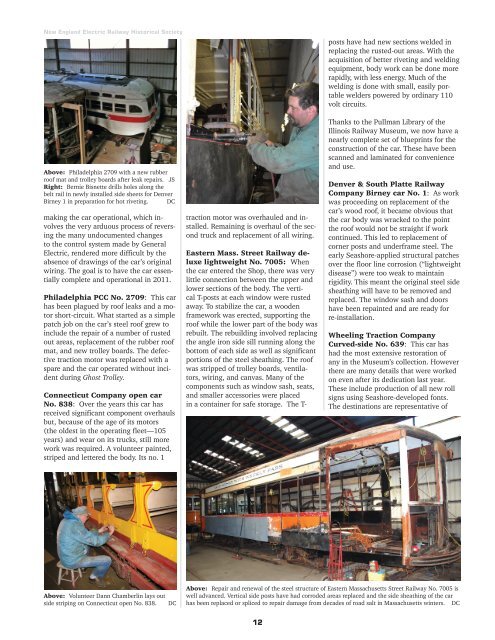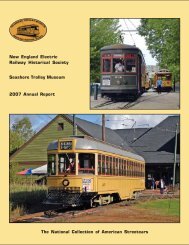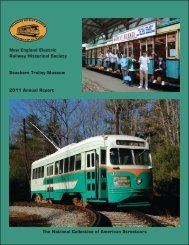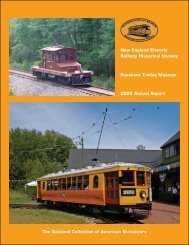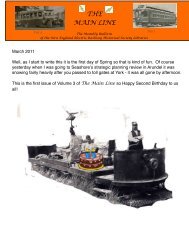2010 Annual Report - the Seashore Trolley Museum
2010 Annual Report - the Seashore Trolley Museum
2010 Annual Report - the Seashore Trolley Museum
You also want an ePaper? Increase the reach of your titles
YUMPU automatically turns print PDFs into web optimized ePapers that Google loves.
New England Electric Railway Historical Society<br />
Above: Philadelphia 2709 with a new rubber<br />
roof mat and trolley boards after leak repairs. JS<br />
Right: Bernie Bisnette drills holes along <strong>the</strong><br />
belt rail in newly installed side sheets for Denver<br />
Birney 1 in preparation for hot riveting. DC<br />
making <strong>the</strong> car operational, which involves<br />
<strong>the</strong> very arduous process of reversing<br />
<strong>the</strong> many undocumented changes<br />
to <strong>the</strong> control system made by General<br />
Electric, rendered more difficult by <strong>the</strong><br />
absence of drawings of <strong>the</strong> car’s original<br />
wiring. The goal is to have <strong>the</strong> car essentially<br />
complete and operational in 2011.<br />
Philadelphia PCC No. 2709: This car<br />
has been plagued by roof leaks and a motor<br />
short-circuit. What started as a simple<br />
patch job on <strong>the</strong> car’s steel roof grew to<br />
include <strong>the</strong> repair of a number of rusted<br />
out areas, replacement of <strong>the</strong> rubber roof<br />
mat, and new trolley boards. The defective<br />
traction motor was replaced with a<br />
spare and <strong>the</strong> car operated without incident<br />
during Ghost <strong>Trolley</strong>.<br />
Connecticut Company open car<br />
No. 838: Over <strong>the</strong> years this car has<br />
received significant component overhauls<br />
but, because of <strong>the</strong> age of its motors<br />
(<strong>the</strong> oldest in <strong>the</strong> operating fleet—105<br />
years) and wear on its trucks, still more<br />
work was required. A volunteer painted,<br />
striped and lettered <strong>the</strong> body. Its no. 1<br />
traction motor was overhauled and installed.<br />
Remaining is overhaul of <strong>the</strong> second<br />
truck and replacement of all wiring.<br />
Eastern Mass. Street Railway deluxe<br />
lightweight No. 7005: When<br />
<strong>the</strong> car entered <strong>the</strong> Shop, <strong>the</strong>re was very<br />
little connection between <strong>the</strong> upper and<br />
lower sections of <strong>the</strong> body. The vertical<br />
T-posts at each window were rusted<br />
away. To stabilize <strong>the</strong> car, a wooden<br />
framework was erected, supporting <strong>the</strong><br />
roof while <strong>the</strong> lower part of <strong>the</strong> body was<br />
rebuilt. The rebuilding involved replacing<br />
<strong>the</strong> angle iron side sill running along <strong>the</strong><br />
bottom of each side as well as significant<br />
portions of <strong>the</strong> steel sheathing. The roof<br />
was stripped of trolley boards, ventilators,<br />
wiring, and canvas. Many of <strong>the</strong><br />
components such as window sash, seats,<br />
and smaller accessories were placed<br />
in a container for safe storage. The T-<br />
posts have had new sections welded in<br />
replacing <strong>the</strong> rusted-out areas. With <strong>the</strong><br />
acquisition of better riveting and welding<br />
equipment, body work can be done more<br />
rapidly, with less energy. Much of <strong>the</strong><br />
welding is done with small, easily portable<br />
welders powered by ordinary 110<br />
volt circuits.<br />
Thanks to <strong>the</strong> Pullman Library of <strong>the</strong><br />
Illinois Railway <strong>Museum</strong>, we now have a<br />
nearly complete set of blueprints for <strong>the</strong><br />
construction of <strong>the</strong> car. These have been<br />
scanned and laminated for convenience<br />
and use.<br />
Denver & South Platte Railway<br />
Company Birney car No. 1: As work<br />
was proceeding on replacement of <strong>the</strong><br />
car’s wood roof, it became obvious that<br />
<strong>the</strong> car body was wracked to <strong>the</strong> point<br />
<strong>the</strong> roof would not be straight if work<br />
continued. This led to replacement of<br />
corner posts and underframe steel. The<br />
early <strong>Seashore</strong>-applied structural patches<br />
over <strong>the</strong> floor line corrosion (“lightweight<br />
disease”) were too weak to maintain<br />
rigidity. This meant <strong>the</strong> original steel side<br />
sheathing will have to be removed and<br />
replaced. The window sash and doors<br />
have been repainted and are ready for<br />
re-installation.<br />
Wheeling Traction Company<br />
Curved-side No. 639: This car has<br />
had <strong>the</strong> most extensive restoration of<br />
any in <strong>the</strong> <strong>Museum</strong>’s collection. However<br />
<strong>the</strong>re are many details that were worked<br />
on even after its dedication last year.<br />
These include production of all new roll<br />
signs using <strong>Seashore</strong>-developed fonts.<br />
The destinations are representative of<br />
Above: Volunteer Dann Chamberlin lays out<br />
side striping on Connecticut open No. 838.<br />
DC<br />
Above: Repair and renewal of <strong>the</strong> steel structure of Eastern Massachusetts Street Railway No. 7005 is<br />
well advanced. Vertical side posts have had corroded areas replaced and <strong>the</strong> side sheathing of <strong>the</strong> car<br />
has been replaced or spliced to repair damage from decades of road salt in Massachusetts winters. DC<br />
12


